Reading Time: 18 min
In Indian culture, Surya (also known as Aditya) is the Sun god. He is regarded as the source of all life and the supreme soul who brings light and warmth to the world. Traditionally, the practice of Surya Namaskar was used as a means of paying respect to the sun. The term is derived from two Sanskrit words-surya meaning ‘sun’ and namaskar meaning ‘greetings’/’salutations’. In Hinduism, Surya is understood to be the creator of the universe and in Vedic tradition the sun symbolizes consciousness and the Divine. Surya Namaskar is generally considered to be a morning practice, designed to harness the prana shakti (life energy) which is in
abundance at dawn.
I have always read in books about Surya namaskar but never really tried to do it myself maybe due to many reasons like busy lifestyle. But, owing to the lockdown and getting more time to myself, I started doing Surya Namaskar as a regular morning ritual. And it has only benefitted me. I feel rejuvenated and lively. Initially, I was a bit clumsy with the poses but slowly started understanding them and perfecting it as much as possible. And its unbelievable how energetic and nourished I feel after performing the yoga poses. Just invest 30 minutes for doing at least 12 repetitions of the Surya Namaskar poses(six on each side). We might feel lazy in the beginning but once you get the zest of it, you will wake up and find time for yourself. Keep reading to see the benefits and the steps of Surya Namaskar.
A brief history…
Surya Namaskar dates back to the Treta Yuga when Rama had to fight with Ravana to reclaim his wife, Sita. The Aditya Hridayam form of Surya Namaskara is taught to Rama by the sage Agastya. It is described in the Yuddha Khanda Canto (#107) of the Ramayana. In the 1920s, Bhawanrao Shriniwasrao Pant Pratinidhi, the Rajah of Aundh, popularized and named the practice, describing it in his 1928 book ‘The Ten-Point Way to Health:Surya Namaskars’. In 1934, T.Krishnamacharya, considered to be the father of modern Hatha yoga has described Surya Namaskar as a sequence of asanas in the book, Yoga Makaranda. It provides a complete work-out for body, mind and spirit.
Benefits and steps
The sequence stimulates all muscles, organs, systems and chakras in addition to cultivating concentration and stillness of mind. It is an energizing and efficient way to connect with inner strength and stability and is often used as a warm-up at the start of a longer yoga practice.
Step 1. Pranamasana प्रणामासन (Prayer/Mantra Pose)
Breath: Exhale
Praṇāma is a form of respectful or reverential salutation (or reverential bowing) before something or another person usually grandparents, parents, elders or teachers or someone deeply respected such as a deity. It is found in Indian culture and Hindu traditions.
Stand in an erect position by placing your feet together and balance your weight equally on both feet. Expand your chest and relax your shoulders. As you breathe in, bring your palms together facing each other parallel to the chest in Namaskar posture and exhale. Take deep breaths to relax the body and follow it with a couple of more breaths so that the pranic energy refreshes you. Close your eyes, focus on the central part of your brain.
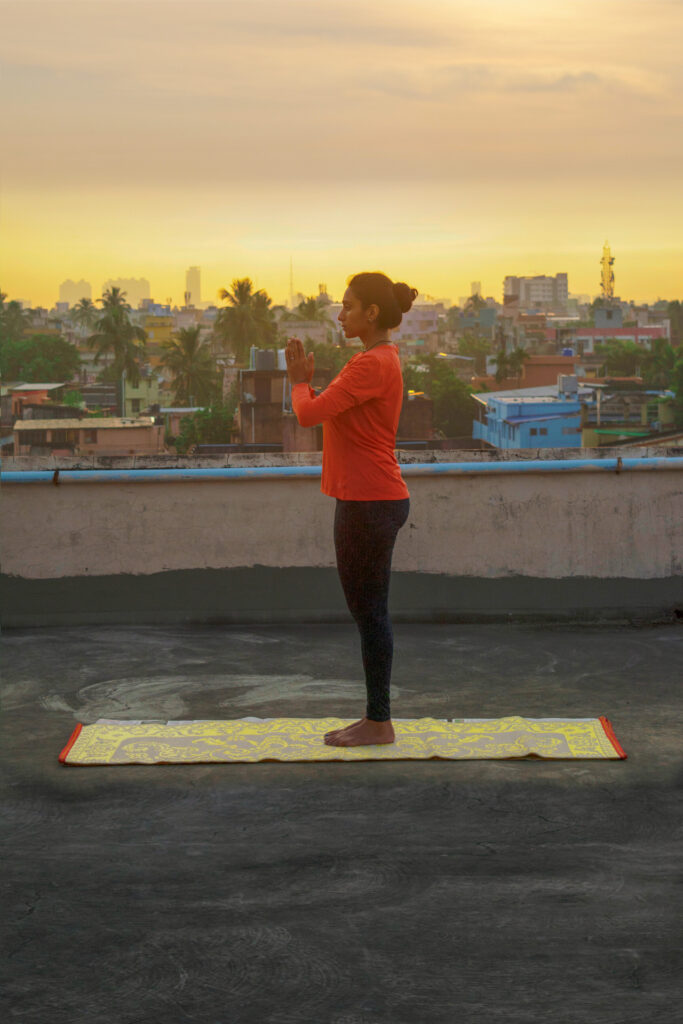
Health Benefits
Improves body posture, promotes relaxation in the body, instills spiritual energy, stabilizes the body and mind, brings mental calmness and nourishes the leg muscles and bones.
Step 2. Hasta Uttanasana हस्त उत्तानासन (Raised Arms Pose)
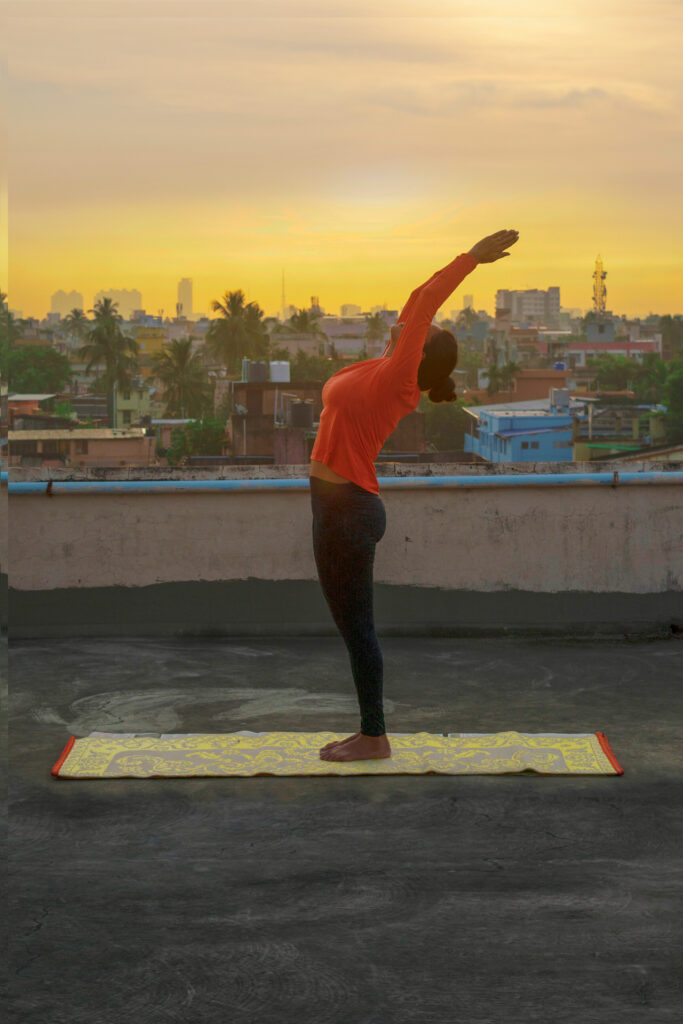
Breath: Inhale
Stand with your legs straight, arms by your side, spine long and feet together. Lengthen your spine and stretch your arms above shoulder-width apart. Join the hands together softly. Slightly tilt your upper body backward and gaze up to the thumbs. As you tilt your head and neck back, make sure you do not strain them. In this pose, the effort is to stretch the whole body up from the heels to the tips of the fingers.
To deepen this yoga stretch you may push the pelvis forward a little bit. Ensure you’re reaching up with the fingers rather than trying to bend backward.
Health Benefits
Expands and opens the chest, tones the back muscles, balances the Anahata Chakra(heart), works on abdominal organs and muscles, calms the brain and induces meditative state.
Step 3. Pada Hastasana पादहस्तासन (Hand-to-foot Pose)
Breath: Exhale
Breathing out, bend forward from the waist keeping the spine erect. As you exhale completely, bring the hands down to the floor.
To deepen this yoga stretch you may bend the knees, if necessary, to bring the palms down to the floor. Now make a gentle effort to straighten the knees.
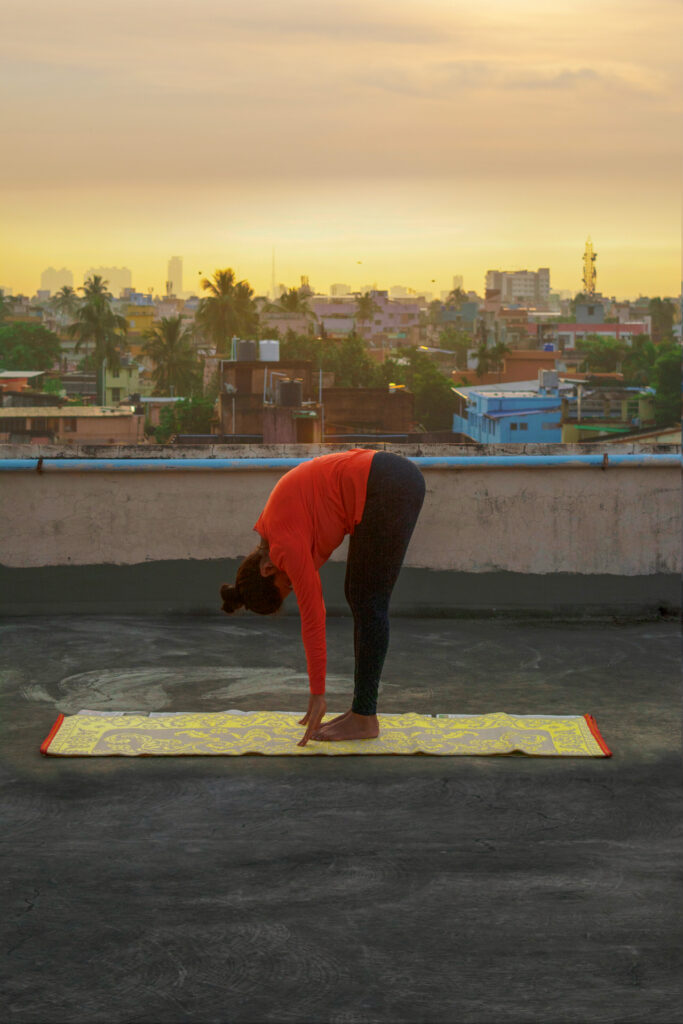
Health Benefits
Stretches the hamstrings, therapeutic for carpal tunnel syndrome, improves blood flow, stress eliminator, better posture, speeds up metabolism and keeps the digestive tract healthy, well functioning spleen and liver, healthy for nasal and throat problems, stay healthy and young.
Step 4. Ashwasanchalanasana अश्व संचालनासन (Equestrian Pose)
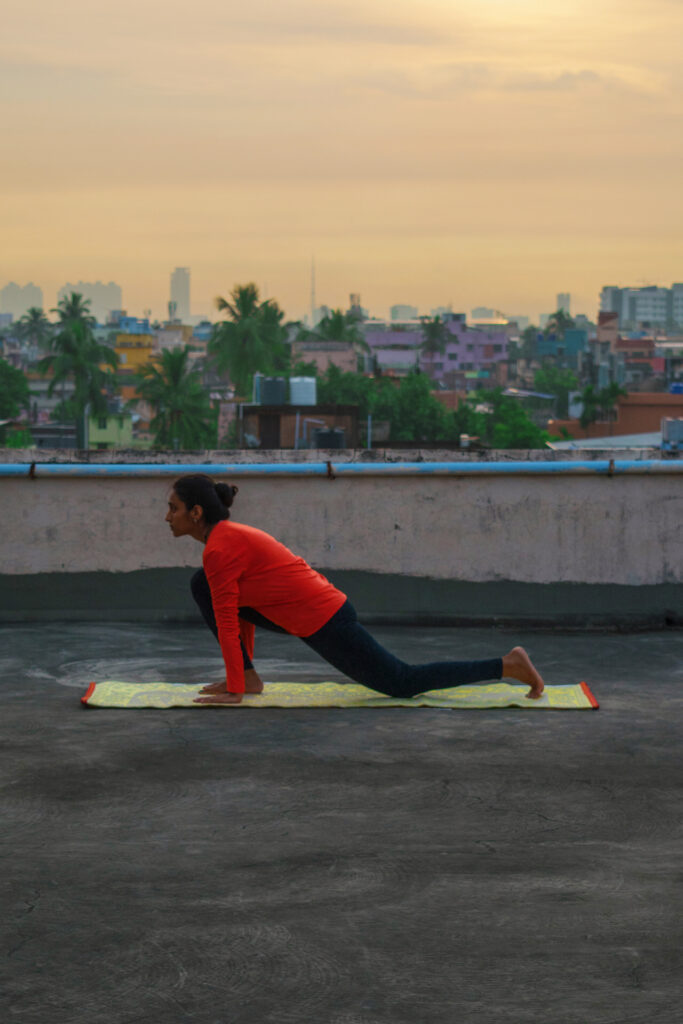
Breath: Inhale
Breath in and push your left leg back and touch the left knee on the floor. Straighten the back as much as possible. The right foot should be placed between your palms and the knee should be perpendicular to the floor. To deepen this yoga stretch place the right foot exactly between the two hands and the right calf perpendicular to the floor. In this position, make a gentle effort to push the hips down towards the floor.
Health Benefits
This pose is also known as the Equestrian pose and is great for improving lung capacity and strengthening your spine. It also increases the flexibility of your back and strengthens the muscles of your chest, leads to better functioning of the liver and tones your kidneys, improves your digestion. Strengthens your knees, quadriceps, legs, hips and ankles. Stimulates abdominal organs of the body and helps those suffering from constipation.
Step 5. Parvatasana पर्वतासन (Mountain Pose)
Breath: Exhale
From Ashwa Sanchalanasana, straighten the bent leg and take it backwards. Exhale during this process. Let the right and left foot be together. Raise the buttocks up. Let the two arms be on the floor and support the body weight. Lower the head to be between the two arms. It looks like a mountain and hence the name.
To deepen this yoga stretch try to keep the arms perpendicular to the floor and place the heels on the ground and make a gentle effort to lift the tailbone up.
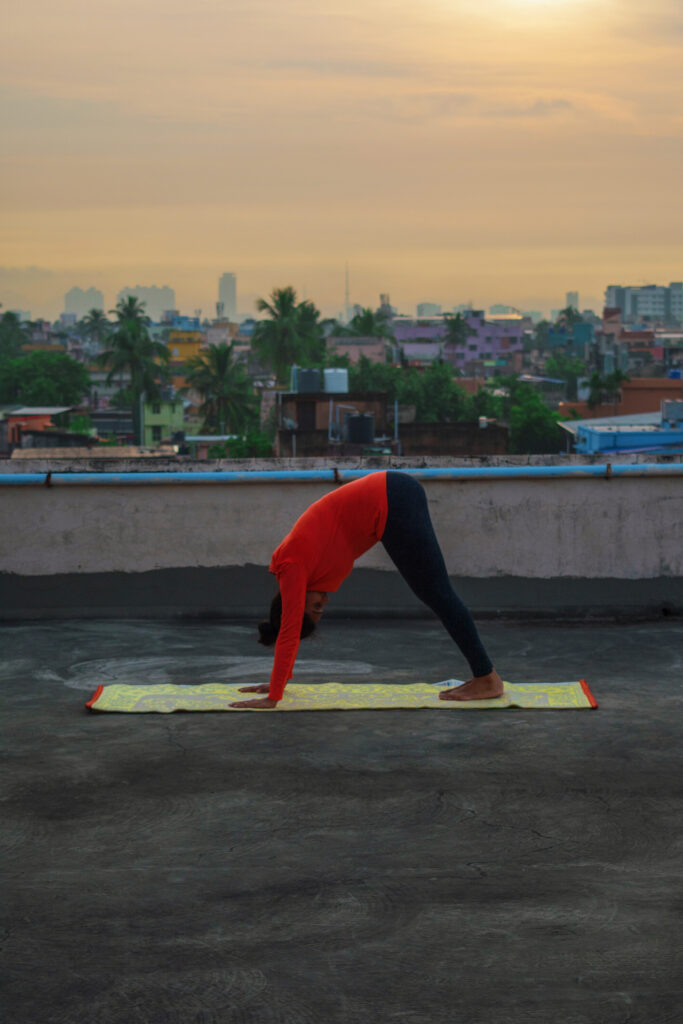
Note: Dandasana (Stick Pose) is also performed by some instead of Parvatasana. As you breathe in, take the left leg back and bring the whole body in a straight line like a plank.
Health Benefits
Strengthens muscles of the shoulders, arms and legs, tones abdominal organs, increases flexibility in the spine, hamstrings and calves, tones the spinal nerves and balances the nervous system and improves the blood circulation to the brain.
Step 6. Ashtanga Namaskar अष्टांग नमस्कार (Eight Limbs Salute)
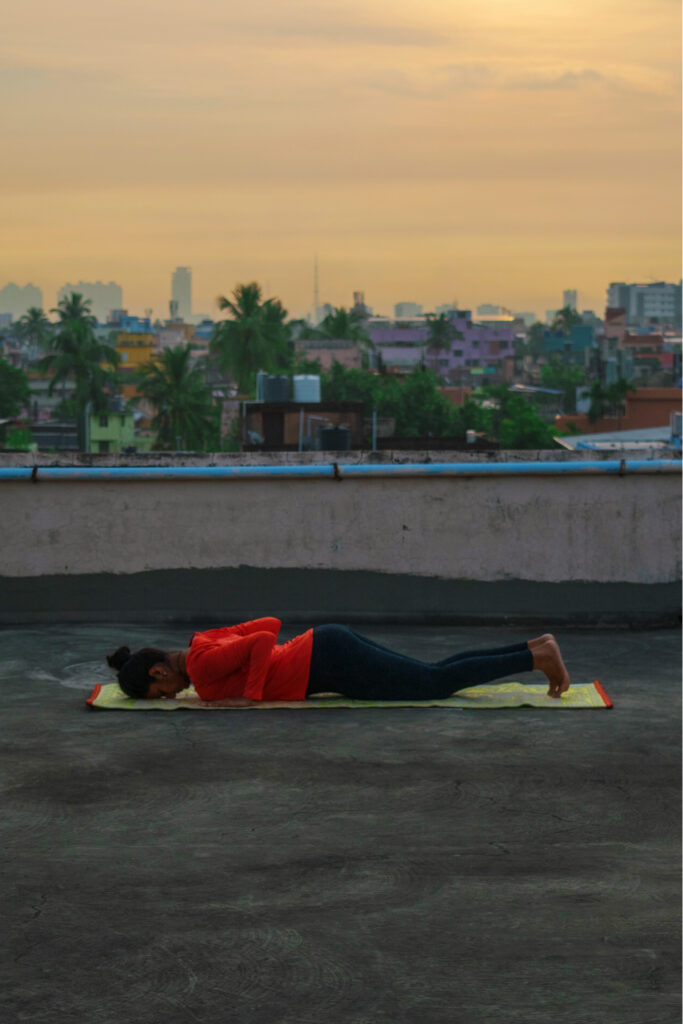
Breath: Hold
From the mountain pose gently bring your knees down to the floor and exhale. Lower your chest and finally the forehead to touch the floor. Take the hips back slightly, slide forward, rest your chest and forehead/chin on the floor. Raise your posterior a little bit. Keep the abdomen and hips off the floor and place your elbows hugging onto your sides. The two hands, two feet, two knees, chest and forehead/chin (eight parts of the body) should touch the floor.
Health Benefits
It helps in strengthening the arms along with the shoulders and legs. This pose also helps in releasing the tension around the neck and shoulders and improves the flexibility of spine and corrects posture. It purifies your body from the outside to inside and enhances your life and body awareness. It stretches and strengthens your muscles as well as your mind thus prepares you towards a healthier and better lifestyle.
Step 7. Bhujangasana भुजंगासन (Cobra Pose)
Breath: Inhale
From the Ashtanga namaskar, slide forward and slowly raise the chest up into the Cobra pose. Look up at the ceiling. Keep your hands close to the body with your palms touching the floor, shoulders away from the ears and straighten your legs.
To deepen this yoga stretch, as you inhale, make a gentle effort to push the chest forward; as you exhale, make a gentle effort to push the navel down. Tuck the toes under. Ensure you’re stretching just as much as you can and not forcing your body.
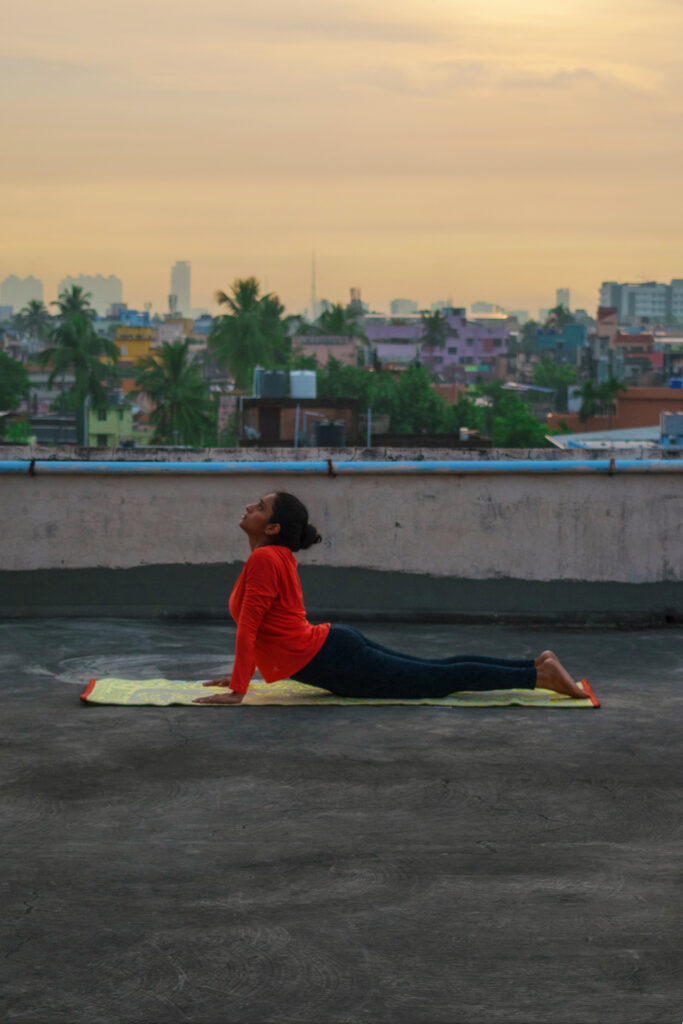
Health Benefits
Stretches muscles in the shoulders, chest and abdominals and decreases stiffness of the lower back. Strengthens the spine , arms and shoulders and increases flexibility. Improves menstrual irregularities, elevates mood, firms and tones the buttocks and stimulates organs in the abdomen like the kidneys, invigorates the heart, relieves stress and fatigue as it improves circulation of blood and oxygen, especially throughout the spinal and pelvic regions, improves digestion.
Step 8. Parvatasana पर्वतासन (Mountain Pose)

Breath: Exhale
From Bhujangasana lift your body up into the mountain pose. Exhale during this process. Let the right and left foot be together. Raise the buttocks up. Let the two arms be on the floor and support the body weight. Lower the head to be between the two arms. It looks like a mountain and hence the name.
To deepen this yoga stretch try to keep the arms perpendicular to the floor and place the heels on the ground and make a gentle effort to lift the tailbone up.
Health Benefits
Strengthens muscles of the shoulders, arms and legs, tones abdominal organs, increases flexibility in the spine, hamstrings and calves, tones the spinal nerves and balances the nervous system and improves the blood circulation to the brain.
Step 9. Ashwasanchalanasana अश्व संचालनासन (Equestrian Pose)
Breath: Inhale
Breathe in and lunge your right leg forward perpendicular to the floor. Let your stretched left knee touch the floor. Straighten the back as much as possible. The right foot should be placed between your palms.
To deepen this yoga stretch place the right foot exactly between the two hands and the right calf perpendicular to the floor. In this position, make a gentle effort to push the hips down towards the floor.

Health Benefits
This pose is also known as the Equestrian pose and is great for improving lung capacity and strengthening your spine. It also increases the flexibility of your back and strengthens the muscles of your chest, leads to better functioning of the liver and tones your kidneys, improves your digestion. Strengthens your knees, quadriceps, legs, hips and ankles. Stimulates abdominal organs of the body and helps those suffering from constipation.
Step 10. Pada Hastasana पादहस्तासन (Hand-to-foot Pose)

Breath: Exhale
Breathing out, from the Ashwasanchalanasana, rise up and bend forward from the waist keeping the spine erect. Exhale completely keeping your hands down to the floor beside the feet.
To deepen this yoga stretch you may bend the knees, if necessary, to bring the palms down to the floor. Now make a gentle effort to straighten the knees.
Health Benefits
Stretches the hamstrings, therapeutic for carpal tunnel syndrome, improves blood flow, stress eliminator, better posture, speeds up metabolism and keeps the digestive tract healthy, well functioning spleen and liver, healthy for nasal and throat problems, stay healthy and young.
Step 11. Hasta Uttanasana हस्त उत्तानासन (Raised Arms Pose)
Breath: Inhale
Slowly raise up your upper body keeping your legs straight, spine long and feet together. Lengthen your spine and stretch your arms above shoulder-width apart. Join the hands together softly. Slightly tilt your upper body backward and gaze up to the thumbs. As you tilt your head and neck back, make sure you do not strain them. In this pose, the effort is to stretch the whole body up from the heels to the tips of the fingers.
To deepen this yoga stretch you may push the pelvis forward a little bit. Ensure you’re reaching up with the fingers rather than trying to bend backward.

Health Benefits
Expands and opens the chest, tones the back muscles, balances the Anahata Chakra(heart), works on abdominal organs and muscles, calms the brain and induces meditative state.
Step 12. Pranamasana प्रणामासन (Prayer/Mantra Pose)

Breath: Exhale
Finally come back to Pranamasana. Expand your chest and relax your shoulders. As you breathe in, bring your palms together facing each other parallel to the chest in Namaskar posture and exhale. Take deep breaths to relax the body and follow it with a couple of more breaths so that the pranic energy refreshes you. Close your eyes, focus on the central part of your brain. Then, as you exhale, first straighten the body, then bring the arms down. Relax in this position and observe the sensations in your body.
Health Benefits
Improves body posture, promotes relaxation in the body, instills spiritual energy, stabilizes the body and mind, brings mental calmness and nourishes the legs muscles and bones.
In some traditions such as Sivananda, each step of the sequence is combined with a Sanskrit mantra.
- Pranamasana प्रणामासन – Oṃ Mitrāya Namaḥ ॐ मित्राय नमः (affectionate to all)
- Hasta Uttanasana हस्त उत्तानासन – Oṃ Ravaye Namaḥ ॐ रवये नमः (cause of all changes)
- Pada Hastasana पादहस्तासन – Oṃ Sūryāya Namaḥ ॐ सूर्याय नमः (who induces all activity)
- Ashwasanchalanasana अश्व संचालनासन – Oṃ Bhānave Namaḥ ॐ भानवे नमः (who diffuses light)
- Parvatasana पर्वतासन – Oṃ Khagāya Namaḥ ॐ खगाय नमः (who moves in the sky)
- Ashtanga Namaskar अष्टांग नमस्कार – Oṃ Pūṣṇe Namaḥ ॐ पूष्णे नमः (who nourishes all)
- Bhujangasana भुजंगासन – Oṃ Hiraṇya Garbhāya Namaḥ ॐ हिरण्यगर्भाय नमः (who contains everything)
- Parvatasana पर्वतासन – Oṃ Marīcaye Namaḥ ॐ मरीचये नमः (who possesses raga)
- Ashwasanchalanasana अश्व संचालनासन – Oṃ Ādityāya Namaḥ ॐ आदित्याय नमः (God of Gods)
- Pada Hastasana पादहस्तासन – Oṃ Savitre Namaḥ ॐ सवित्रे नमः (who produces everything)
- Hasta Uttanasana हस्त उत्तानासन – Oṃ Arkāya Namaḥ ॐ अर्काय नमः (fit to be worshipped)
- Pranamasana प्रणामासन – Oṃ Bhāskarāya Namaḥ ॐ भास्कराय नमः (cause of lustre)
This completes one set of Surya Namaskar. Complete the round by repeating the steps. Only this time, start with taking the left foot behind in step number 4 and bringing the right foot forward in step number 10. Once done, you would’ve completed one round of Surya Namaskar.
Does this post also inspire you to practise Surya Namaskar daily? If yes, please let us know. Kindly share with your family and friends if you would like to share the benefits of Surya Namaskar on our health, body and mind.
Subscribe to us below
Read more blogs –

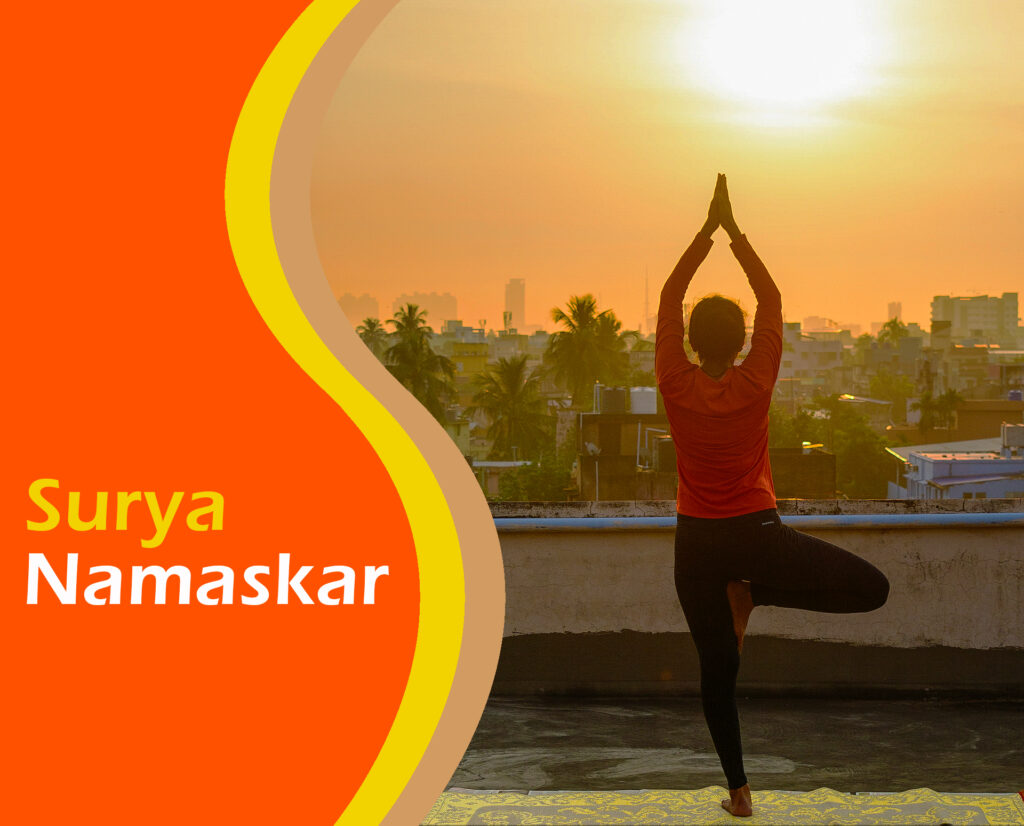
Wow!! This was really very informative & rich in content. Thanks for sharing. Most of us know what is Surya Namaskar but the in-depth knowledge on health benefits, the individual asanas & shlokas discussed are so interesting.
Thank you so much for providing your feedback and for being our consistent reader.:)
Rich content
Thank you so much!
NIce Content loved it totally!! Thank you so much, It was really helpful!! Hope to get much more like this!!
.
.
link: https://fitnesstepz.com/unbelievable-benefits-of-surya-namaskar-and-how-to-do-it/